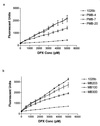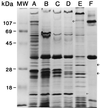Isolation of polymyxin B-susceptible mutants of Burkholderia pseudomallei and molecular characterization of genetic loci involved in polymyxin B resistance
- PMID: 10543742
- PMCID: PMC89538
- DOI: 10.1128/AAC.43.11.2648
Isolation of polymyxin B-susceptible mutants of Burkholderia pseudomallei and molecular characterization of genetic loci involved in polymyxin B resistance
Abstract
Burkholderia pseudomallei is a gram-negative bacterium that causes the disease known as melioidosis. This pathogen is endemic to Southeast Asia and northern Australia and is particularly problematic in northeastern Thailand. It has been previously reported that B. pseudomallei is resistant to the killing action of cationic antimicrobial peptides, including human neutrophil peptide, protamine sulfate, poly-L-lysine, magainins, and polymyxins. Recently, we have also found that the virulent clinical isolate B. pseudomallei 1026b is capable of replicating in media containing polymyxin B at concentrations of >100 mg/ml. In order to identify genetic loci that are associated with this particular resistance phenotype, we employed a Tn5-OT182 mutagenesis system in coordination with a replica plating screen to isolate polymyxin B-susceptible mutants. Of the 17,000 Tn5-OT182 mutants screened via this approach, five polymyxin B-susceptible mutants were obtained. Three of these mutants harbored Tn5-OT182 insertions within a genetic locus demonstrating strong homology to the lytB gene present in other gram-negative bacteria. Of the remaining two mutants, one contained a transposon insertion in a locus involved in lipopolysaccharide core biosynthesis (waaF), while the other contained an insertion in an open reading frame homologous to UDP-glucose dehydrogenase genes. Isogenic mutants were also constructed via allelic exchange and used in complementation analysis studies to further characterize the relative importance of each of the various genetic loci with respect to the polymyxin B resistance phenotype exhibited by B. pseudomallei 1026b.
Figures






References
-
- Brett P J, DeShazer D, Woods D E. Burkholderia thailandensis sp. nov., description of a Burkholderia pseudomallei-like species. Int J Syst Bacteriol. 1998;48:317–320. - PubMed
Publication types
MeSH terms
Substances
LinkOut - more resources
Full Text Sources
Other Literature Sources
Medical

